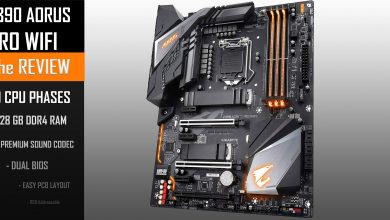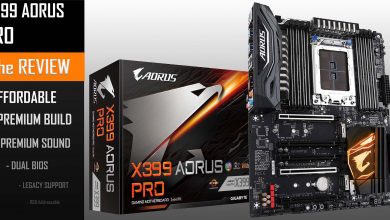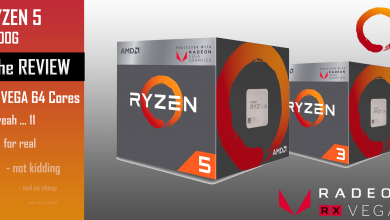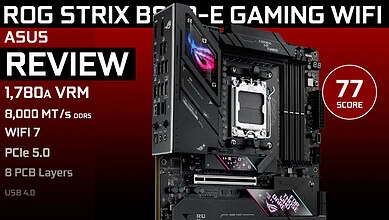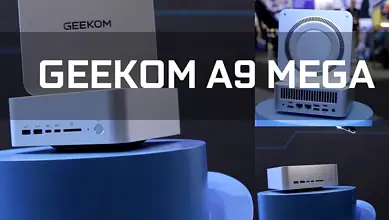Key Features
- Price: 500 USD
- Release Date : 3rd October 2022
- ATX Form Factor / 8 PCB layers + 2 copper layers
- AMD X670E chipset
- AM5 LGA 1718 CPU socket
- CPU Support
- Ryzen 7000
- Ryzen 8000
- Ryzen 9000
- x4 32GB 6,666 MHz DDR4, maximum 128 GB
- x3 PCIe x16 ( x1 PCIe 5.0*16, x1 PCIe 4.0*4, x1 PCIe 3.0*2 )
- Back IO :
- HDMI 2.1
- DP 1.4
- x2 USB 2.0 RX/TX 480 Mbps
- x4 USB 3.1 RX/TX 5 Gbps
- x6 USB 3.2 2nd gen. Type-A + TYPE-C RX/TX 10 Gbps
- x1 USB 3.2 2nd Gen 2×2 Type-C RX/TX 20 Gbps
- FLASH back buttons
- Surge protected 2.5Gbps LAN controller
- WiFi 6E / BT 5.3
- Realtek ALC 4080 Codec 7.1 channels audio,
- STORAGE
- x4 M.2 SSD (x2 PCIe 5.0 | x2 PCIe 4.0)
- x6 SATA 3 — RX/TX 6 Gbps
- CPU powered by x16 105 AMPS power stages
- Great Premium integrated AUDIO (WIMA capacitors)
- Fast DDR5 RAM support (6.66 GHz)
- No DUAL GPU Support
- Only 2 PCIe 5.0 enabled M.2 SSD connectors
- Under equipped back IO
AORUS is Gigabyte more expensive, premium gamer focuses family of Product, and the MASTER one of its most expensive and higher tier model.
It is a concentrate of luxurious features, power and robustness. When you fold one of these things in hand you can tell, it has been engineered!
And with the X670E, it receives the PCIE 5.0 treatment, which means a bandwidth explosion… if bandwidth were to explode.
Most importantly, the MASTER is now 2 boards in one since AORUS has decide to axe its PRO series which used to bridge the ELIT to the MASTER.
In short, Gigabyte simply cannot afford to get this one wrong.
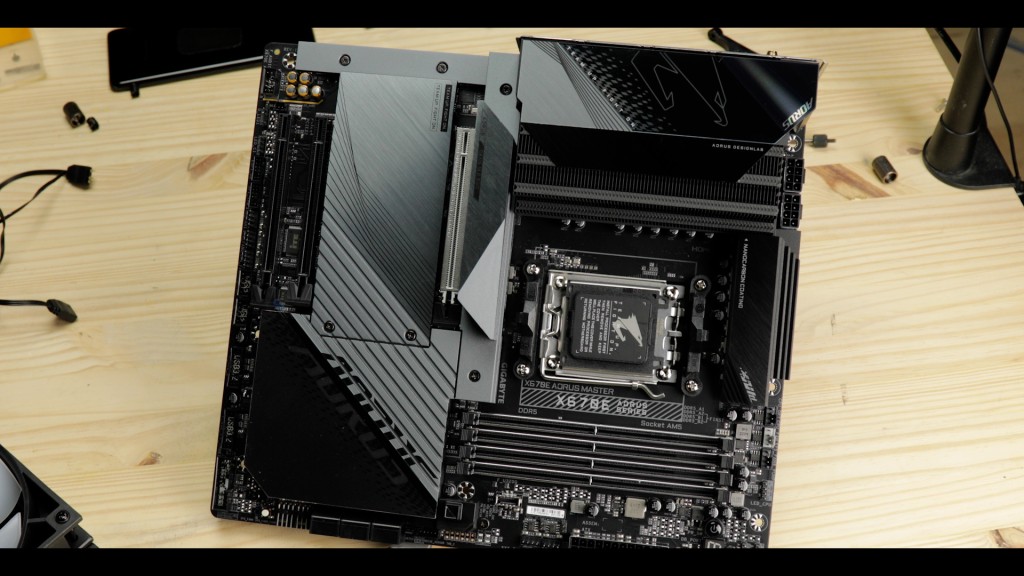
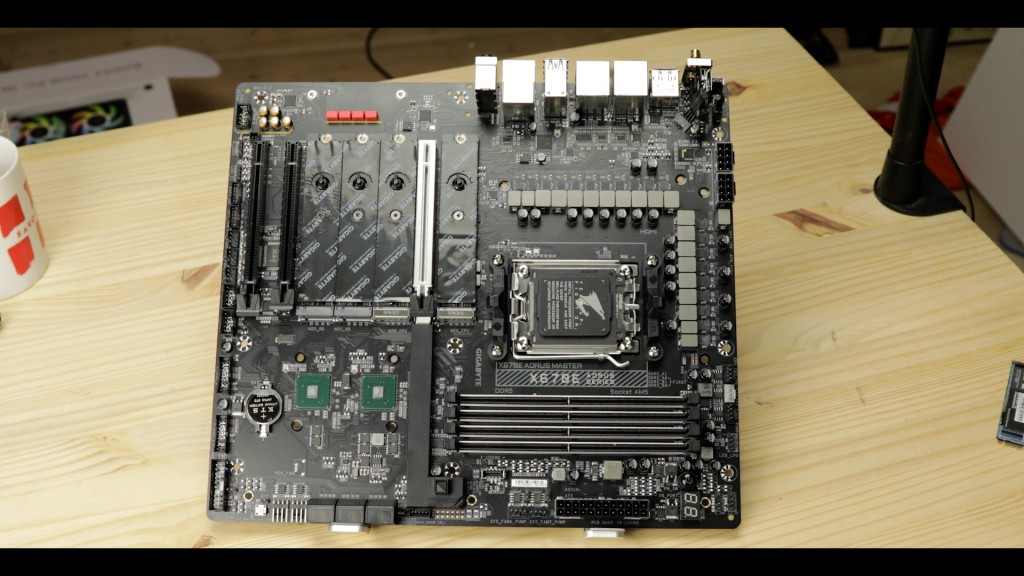
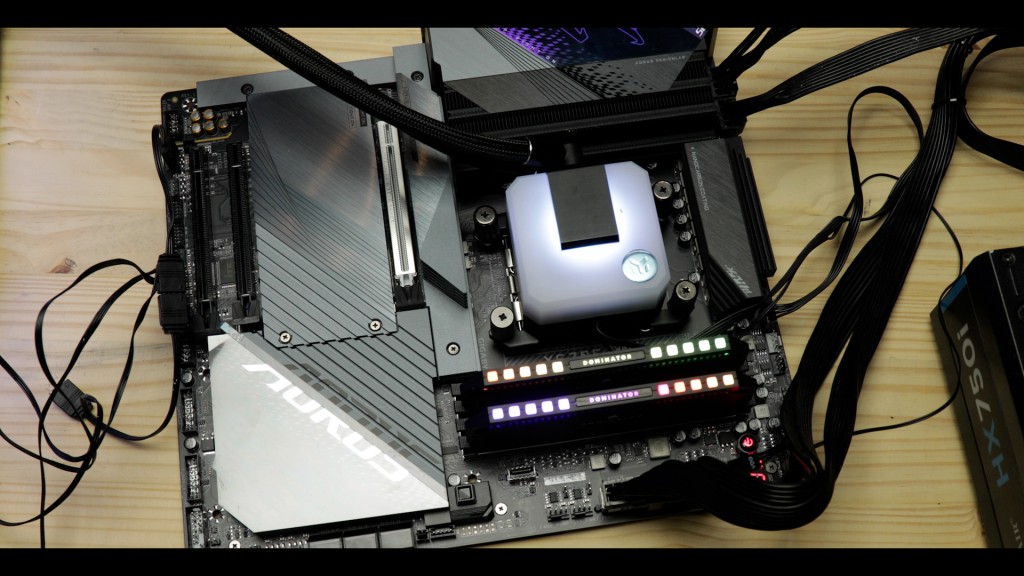
PCB
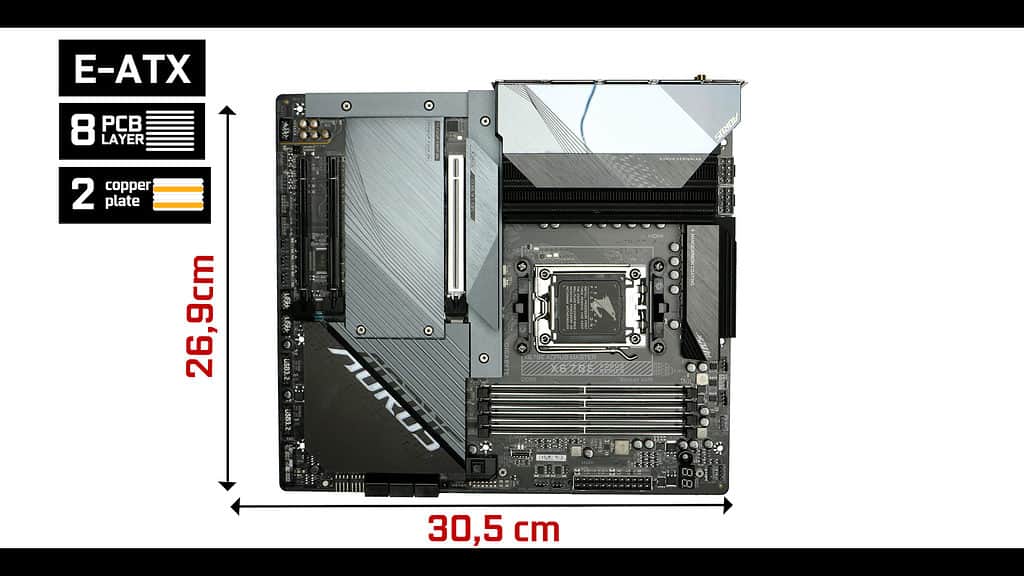
We are dealing with a very robust 8 PCB layered E-ATX motherboard.
Having as many as 8 PCB layers does have heavy consequences on about everything around the board.
It means a better VRM heat-diffusion, a better PCIe signal insulation, and an overall longer life span.
A fundamental which solidly seats the X670E AORUS MASTER in the premium board category.
AM5 LGA 1718
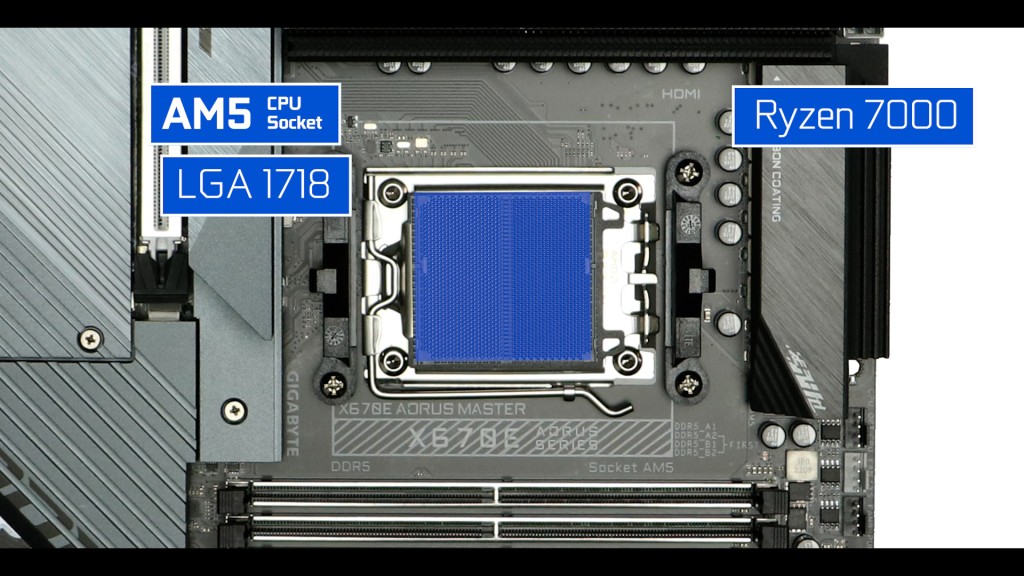
Our LGA1718 socket can support :
- RYZEN 7000 / 8000 / 9000 series
CPU socket wise, the board is rocking AMD first LGA socket, featuring no less than 1718 low pressure pins, drastically increasing the CPU-sourced bandwidth output, and allowing the introduction of both the latest PCIe 5.0 standard and DDR5 RAM support.
And looking at AMD track record, it is safe to say that the AM5 CPU socket will be supporting quiet a few incoming RYZEN generations.
PCIe 5.0 standard, what is it?:
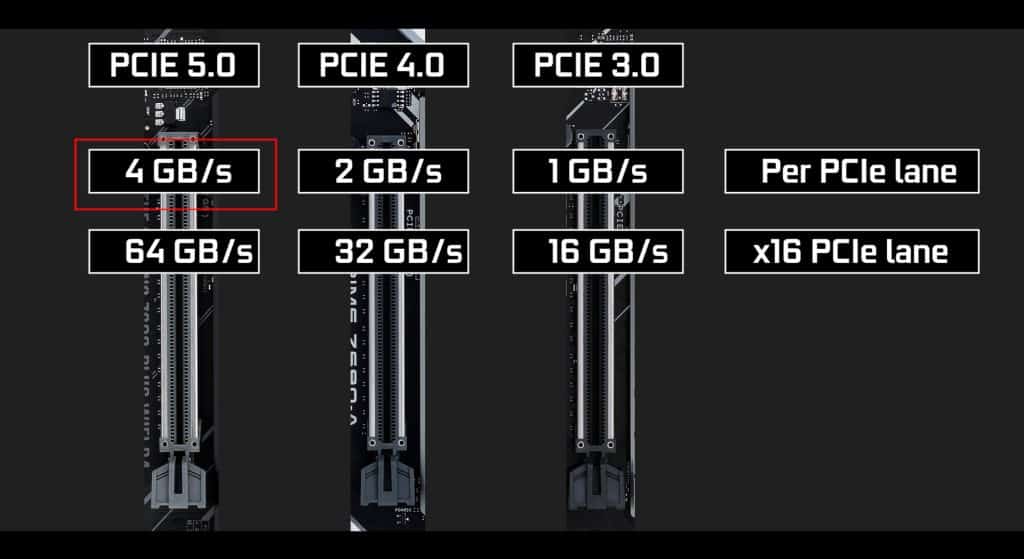
The PCIe 5.0 standard doubles its previous PCIe 4.0 bandwidth, going from 2 GB/s per PCIe lane, to 4 GB/s per PCIe lane.
This evolution brought in by Intel surprised the industry since there is no components, currently, which can use this new standard. Graphics Cards are still struggling to go beyond PCIe 3.0 level bandwidth and we do not have PCIe 5.0 enabled M.2 SSD. That last one being predominantly produced in PCIe 3.0 standard as well.
VRM
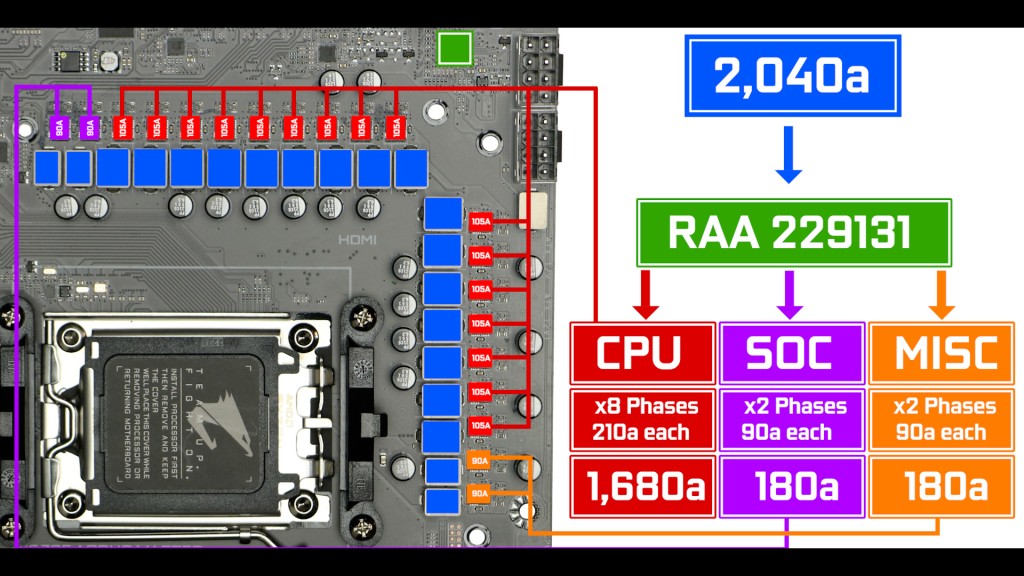
The Gigabyte X670E AORUS MASTER shows off a commending 2040 AMPS worth of power:
- CPU : x16 105 AMPS power phases organized in 8 parallel phase configuration,
- SOC : x2 90 AMPS power phases
- MISC : x2 90 AMPS power phases
Obviously more than enough to juice and power the most demanding CPU the RYZEN 7000 series has to offer.
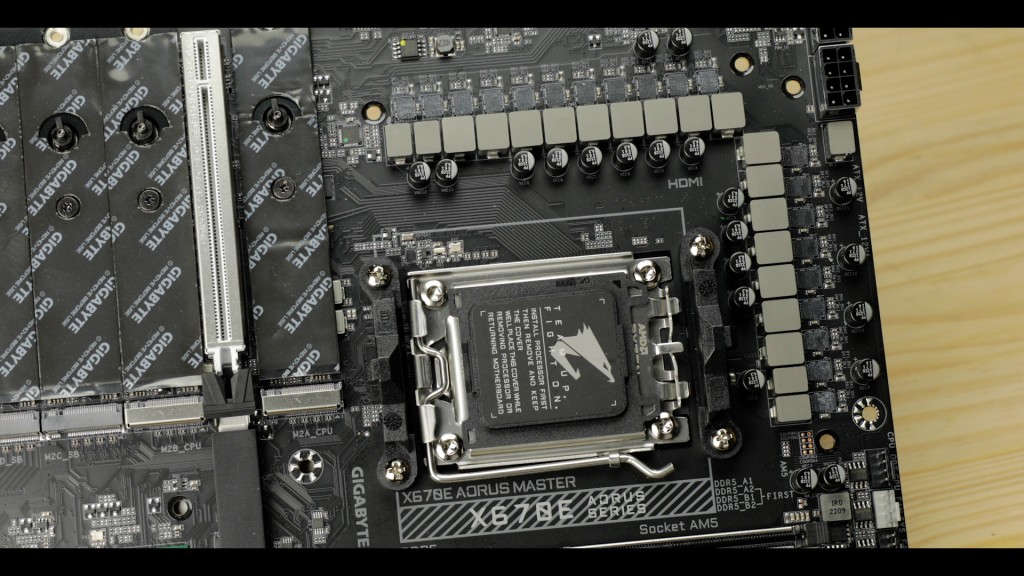
That’s almost 1700 amps worth of power to juice the most demanding compatible RYZEN CPU, which in another life, might have sounded grotesquely overkill, but is one of the very few able to push a RYZEN 9 to OC all its cores to 5.5 Ghz.
VRM Cooling
To keep all that heat at bay, AORUS decided to go bananas, providing this massively imposing and premium 2 VRM block, linked by a wide copper pipe to insure and equal heat spread among them two.
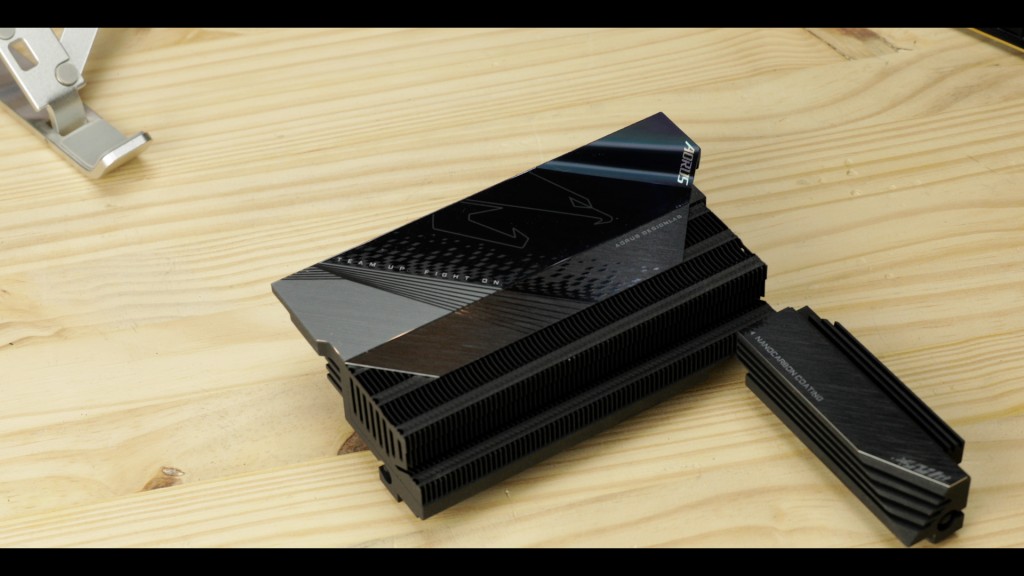
The main block shows off what probably is the very best the industry can do, meaning a fin array bases radiating solution, providing an unprecedented amount of radiation heat, based on a very thick wall to store harvested heat.
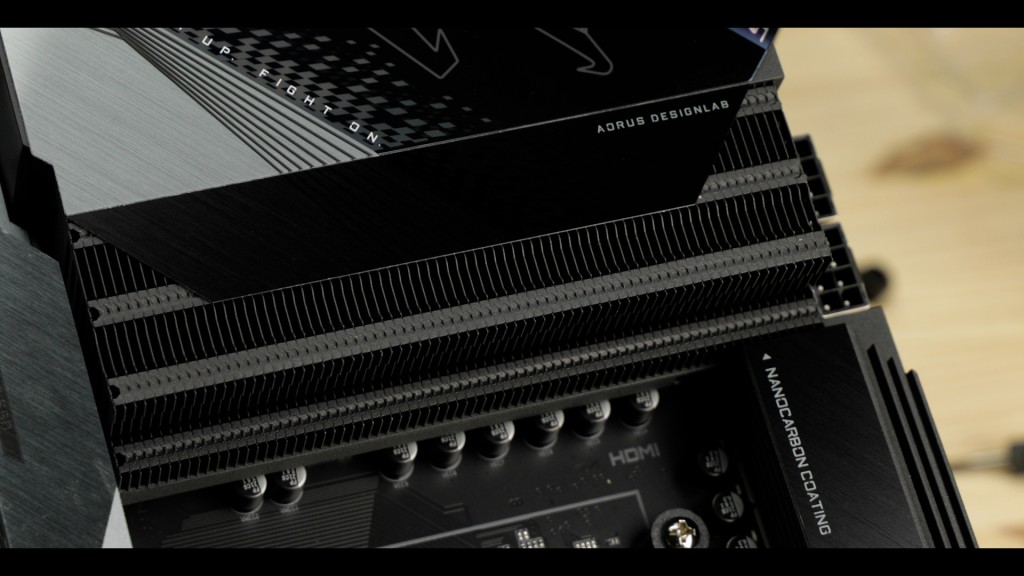
Now to keep that very agile VRM in the cool, ASUS provided a very premium 2 independent cooling blocks.
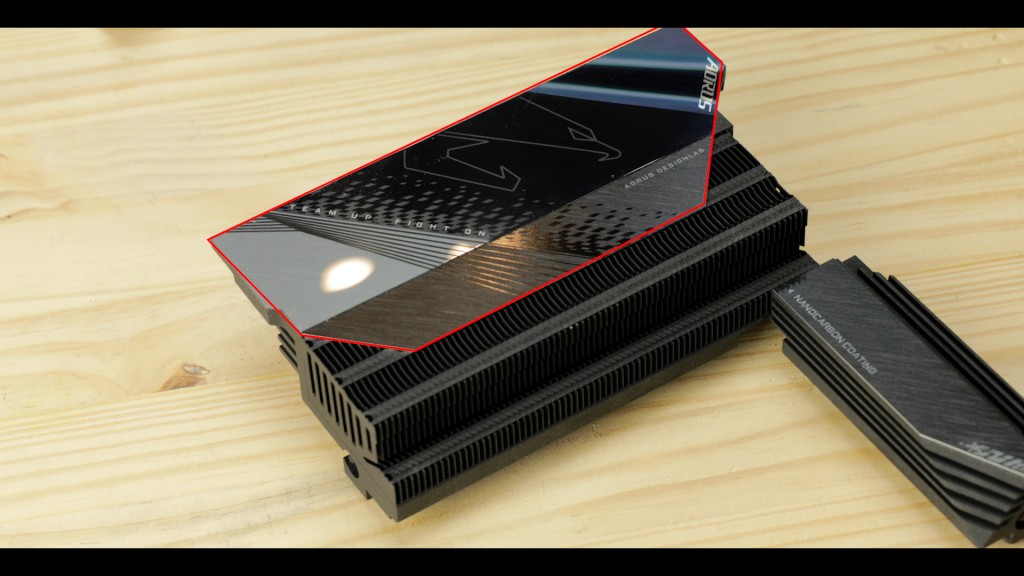
It also has a very large roof area further adding radiating surface to our main block.
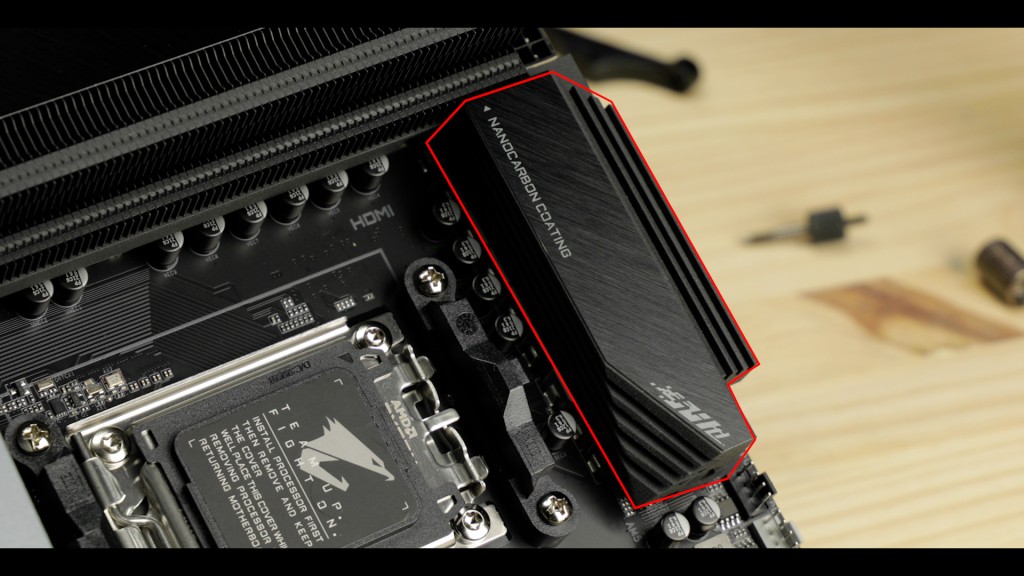
The side block is more standard but manages to radiate quiet a bit of heat as well thanks to its deep and thing fins, equipped on both of its sides.
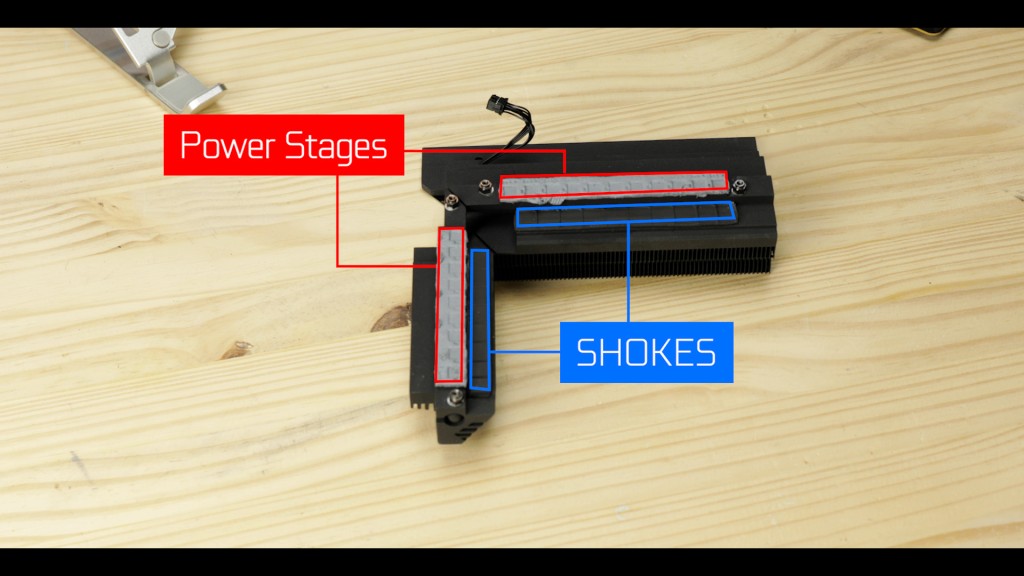
Both block also feature a double contact design providing a direct thermal-padded contact to both chokes and power stages for a faster heat diffusion.
VRM TEMPS
And results are naturally good!
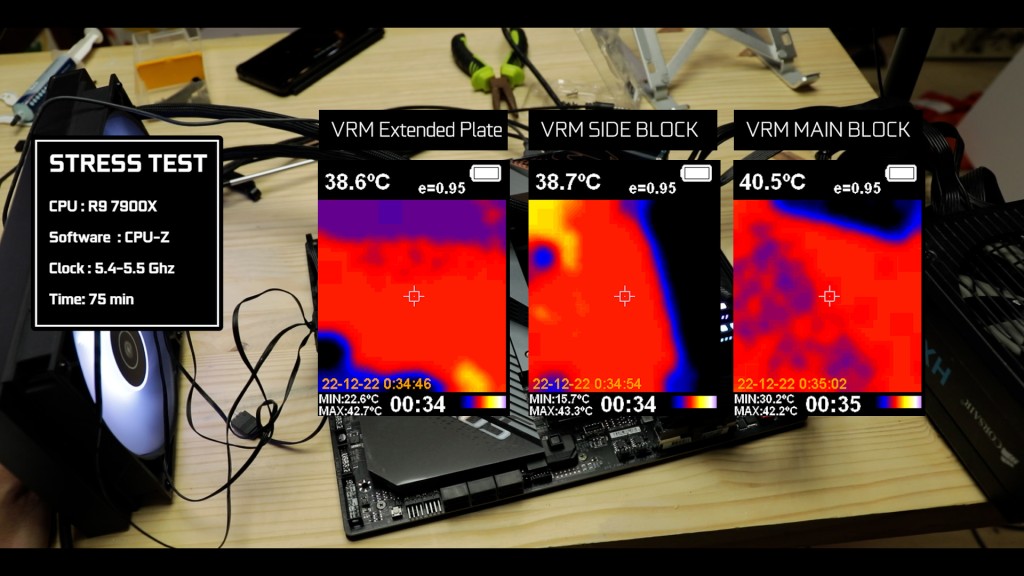
With a severely Overclocked R9 7900X (5.4-5.5 GHz), our blocks stayed below 50c at all time, which promises a minimal heat strain on our circuit hence a more stable product and a prolonged board lifespan.
I cannot imagine this thing running with anything less than a R9 processor, anything else would be pure waisted potential.
RAM
Our GIGABYTE X670E AORUS MASTER supports 128 GB of DDR5 ram overclockable up to a very conservative 6.66 GHz which is the fastest I have seen on an X670E powered board, but well below the 8 GHz you potentially find on Intel Z790 powered motherboards.
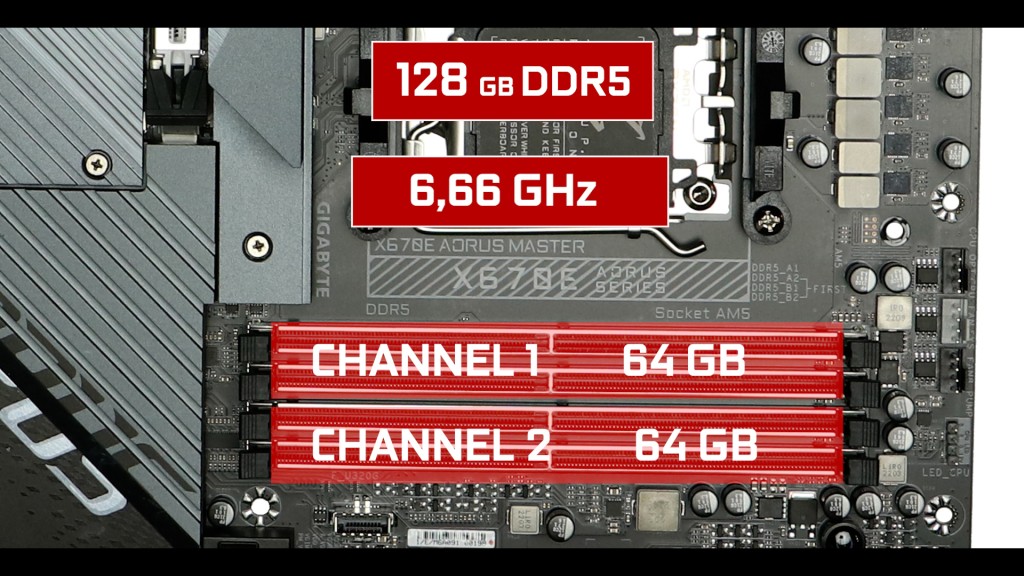
Gaming wise, At these kind of speeds you do start to see a difference when compared to its DDR4 predecessor. But nothing ground breaking.
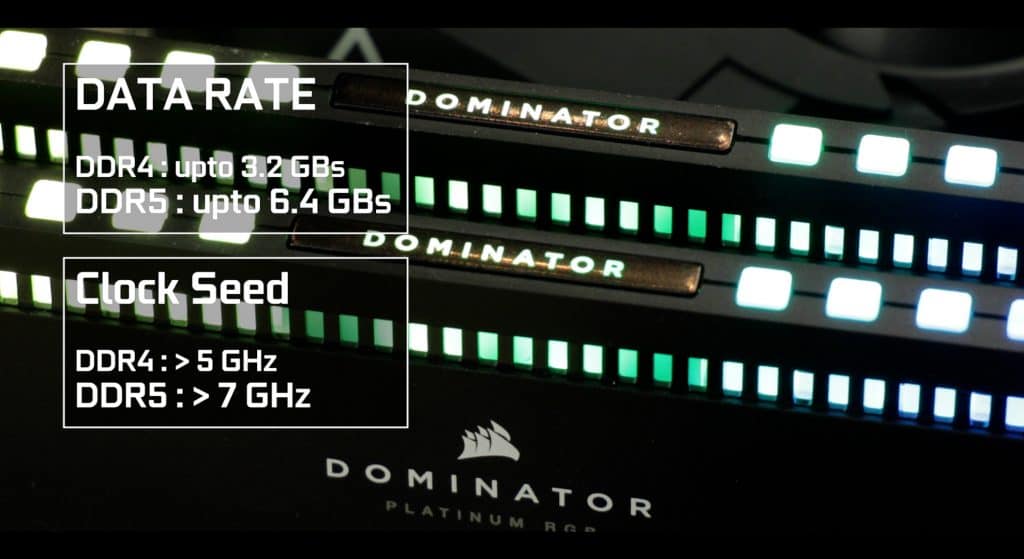
On the other hand, memory intensive task will most benefit from the DDR5 upgraded bandwidth and clock, so definitely a plus for content creators.
M.2 SSD
We have 4 M.2 SSDs, 2 of which are PCIe 5.0 compliant able to swap data upto a whooping 128 Gbs, which is great but is one less PCIe 5.0 compliant M.2 SSD than its main competition the excellent ROG STRIX X670E-E GAMING WiFi that I have reviewed a few weeks ago.
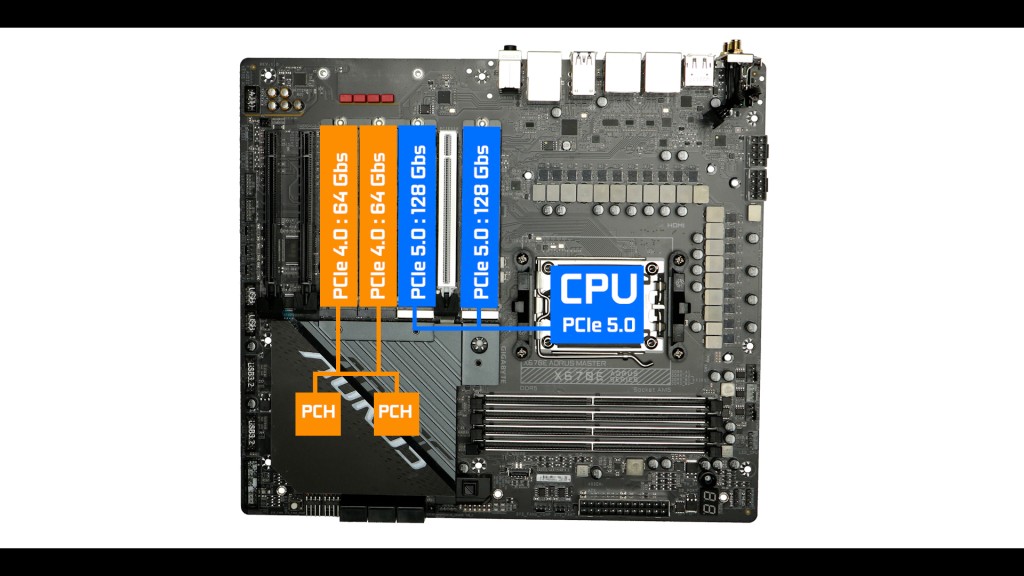
Our 2 other M.2 SSDs runs 4 lanes at PCIe 4.0 standard which translate in a still very fast 64 GBs worth of data swap.
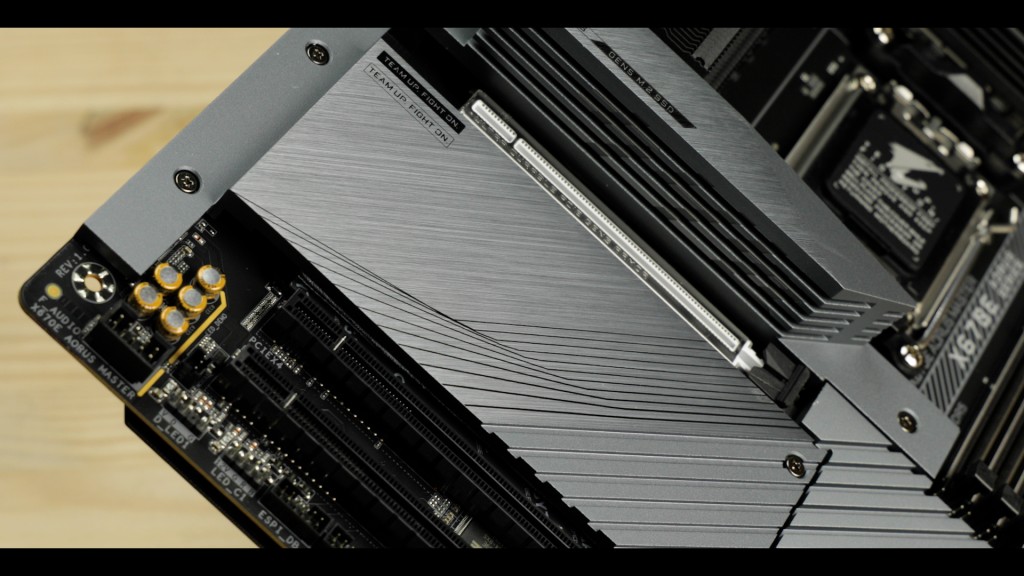
M.2 SSD cooling
All that bandwidth does translate in a lot, and I mean a lot of heat, and AORUS has decided to join the crazy wagon by ,first, featuring a dual side thermal padded contact for a more intimate heat relief
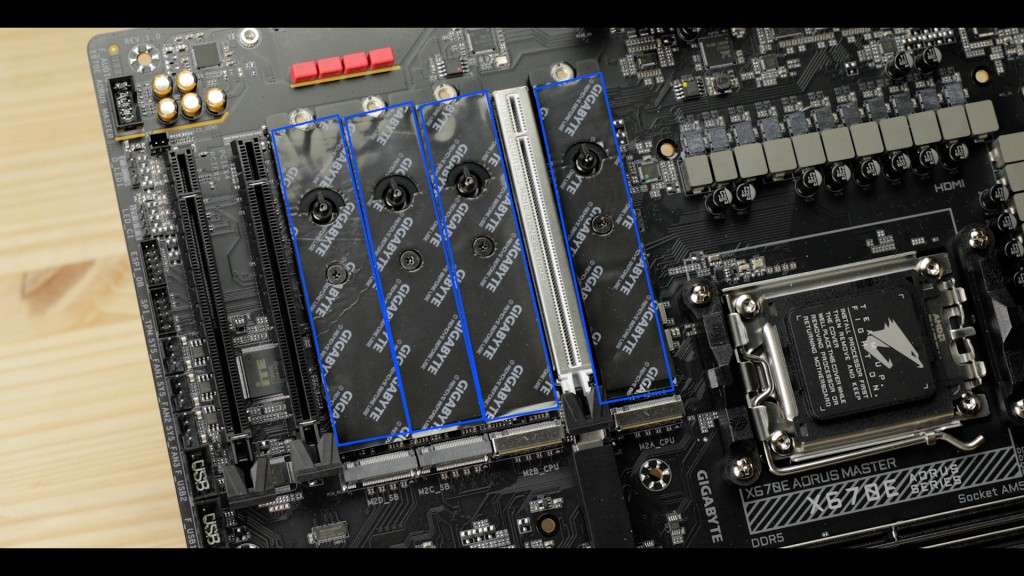
as well as this monstrously tall thermal padded heat block which is surely more show than useful, but does add that cool factor you are paying extra money for.

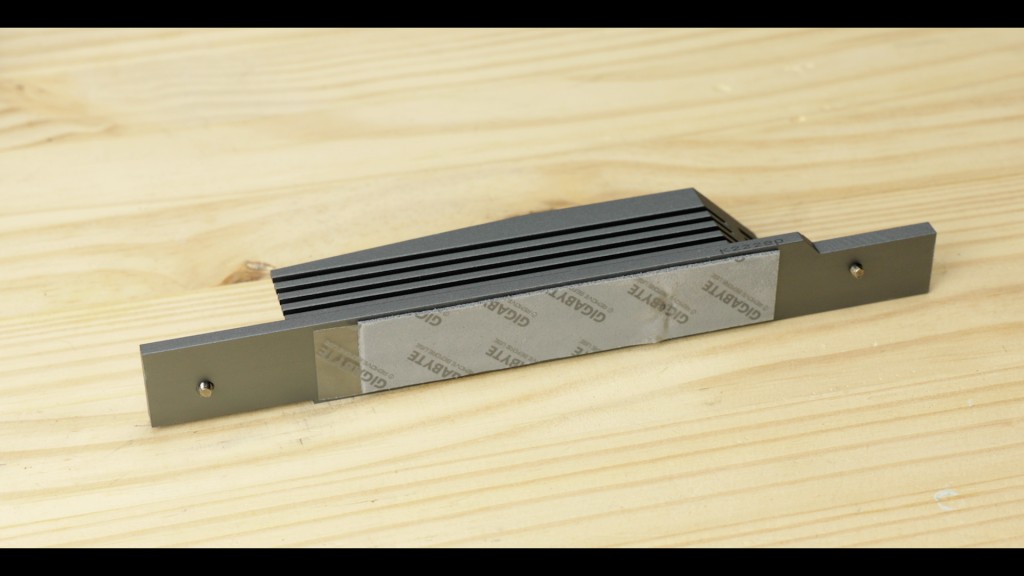
Our 3 others stick get much more classic mono plate, which, thanks to its thickness does also a great job at keeping our M.2 SSDs sticks far from the thermal throttling spaghetti monster.
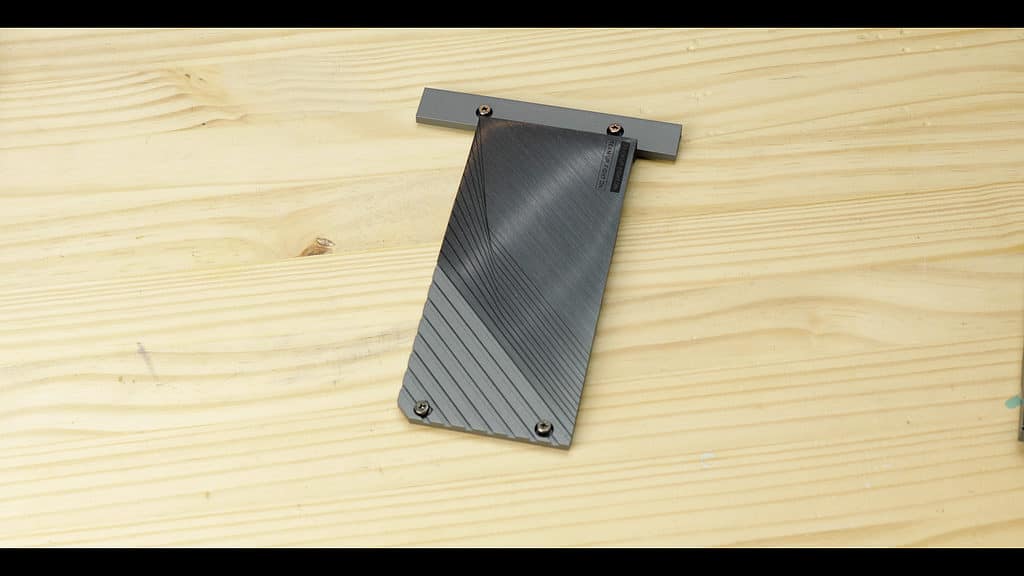
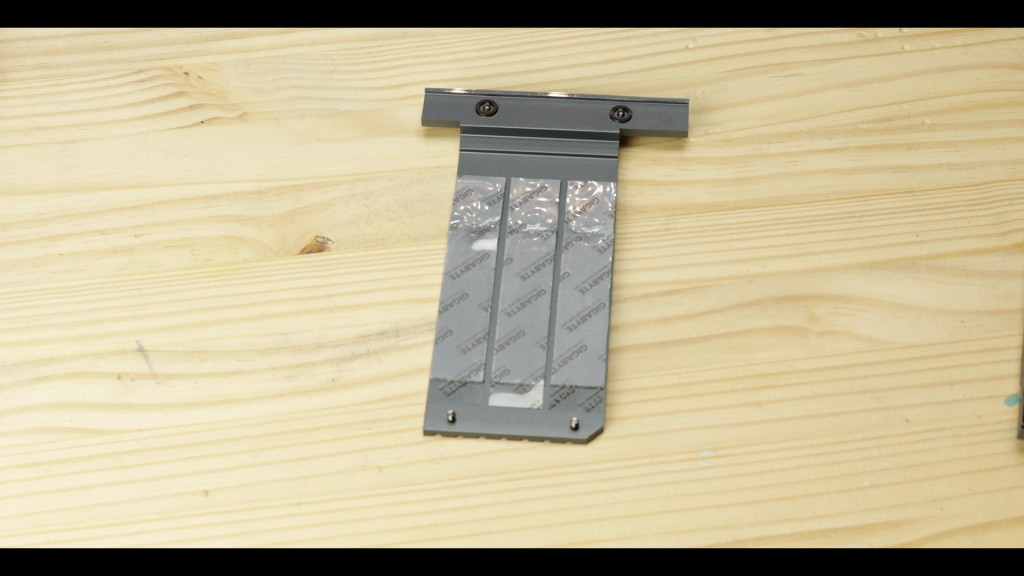
Last but not least, all of our M.2 SSDs are equipped with their own screw less locking mechanism which is quite different from the excellent version we saw on its cheaper ELITE variant.
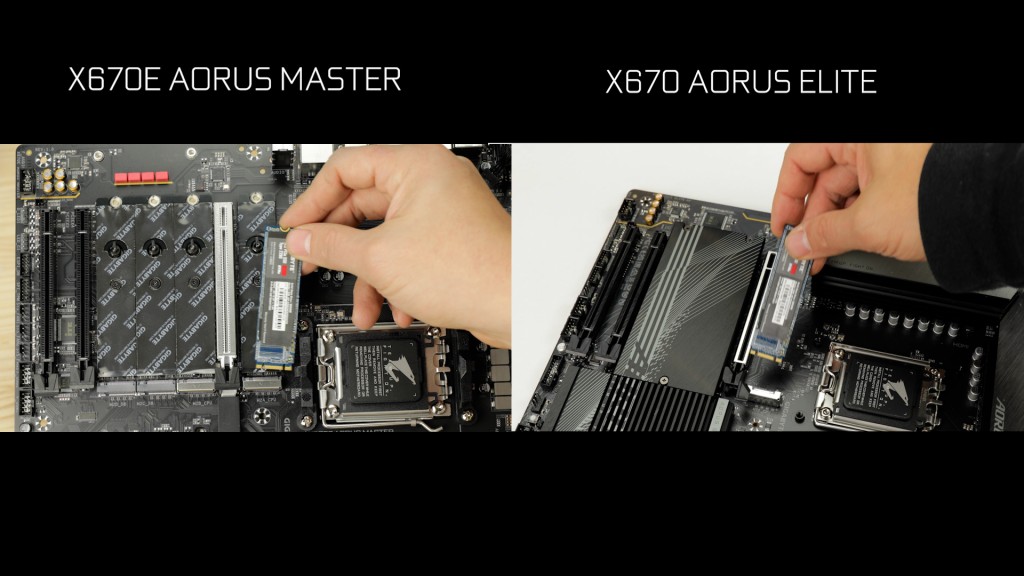
Both are good, but AORUS seems to be still making its mind about that one.
Chipset
Our AORUS MASTER is powered by AMD’s brand new X670 E chipset. Which comes in a dual north/south bridge configuration. Both our chips run a rather low 7 watt heat foot print which has the benefit of needing nothing more than a low profile heat shield to stay cool at all time, which is always a good point.
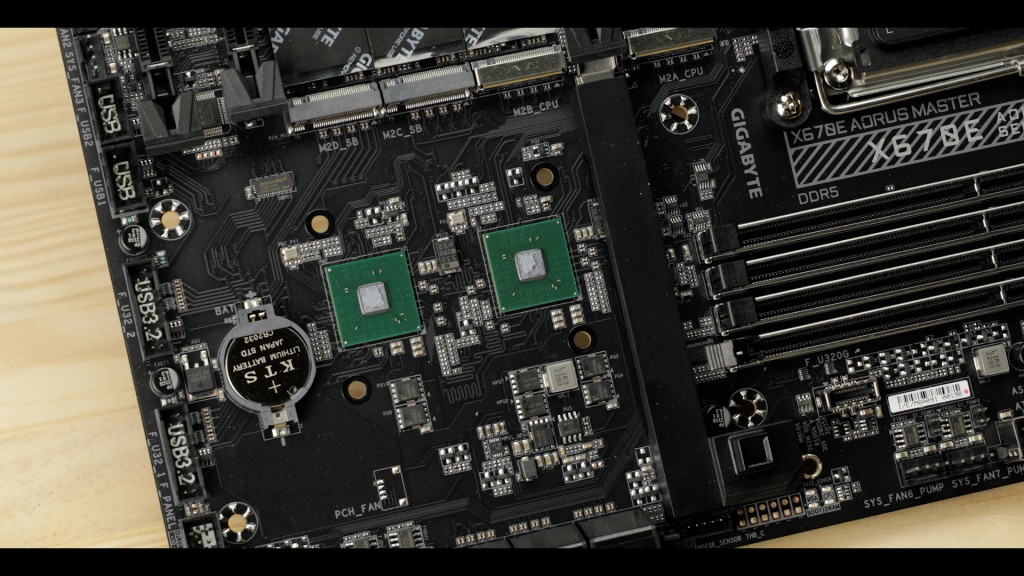
GIGABYTE is the only manufacturer who decided to keep both the CHP chips close to each other which did translate into higher temps as seen on its ELITE variant, but here, we do have a much larger and thicker heat plate, which does a great job et keeping things below 45C. at all times.
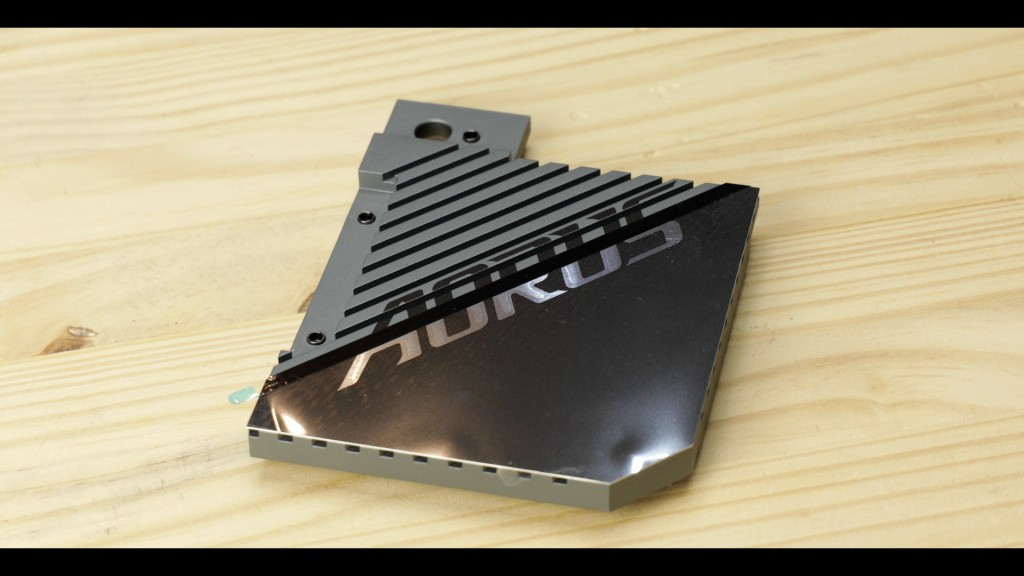
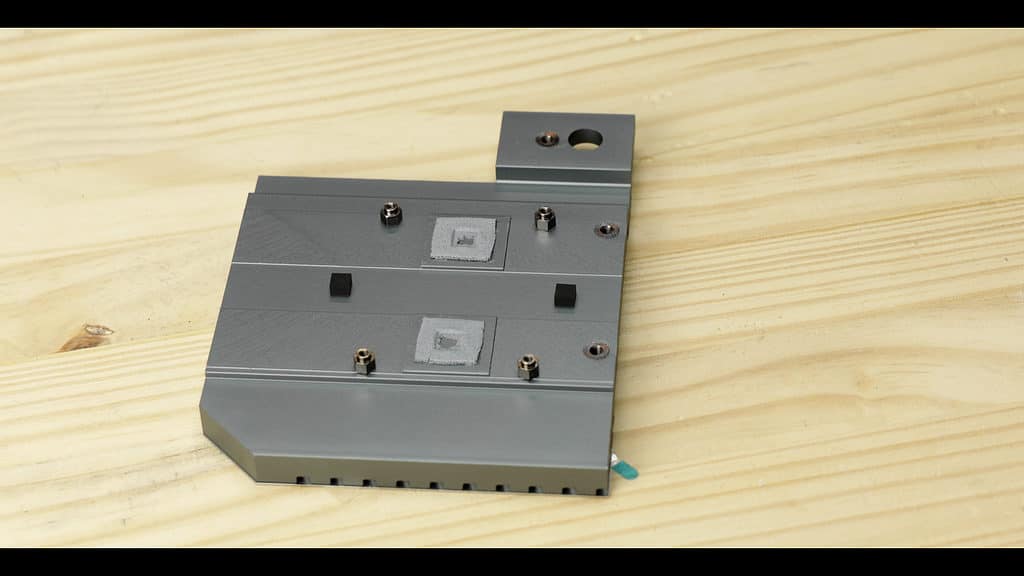
On the inside, we have a bunch of PCIe lanes going in three different PCIe standards directions
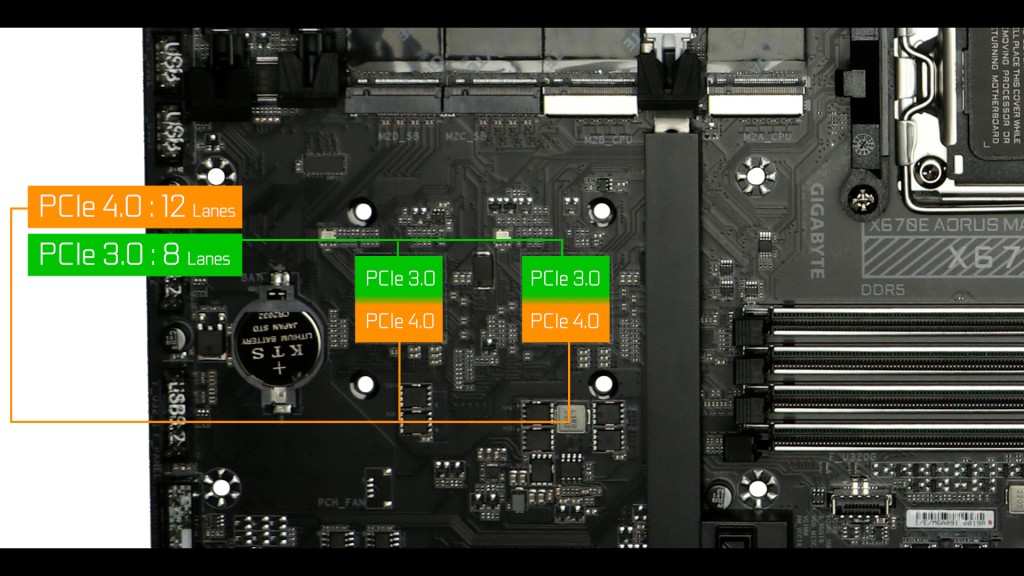
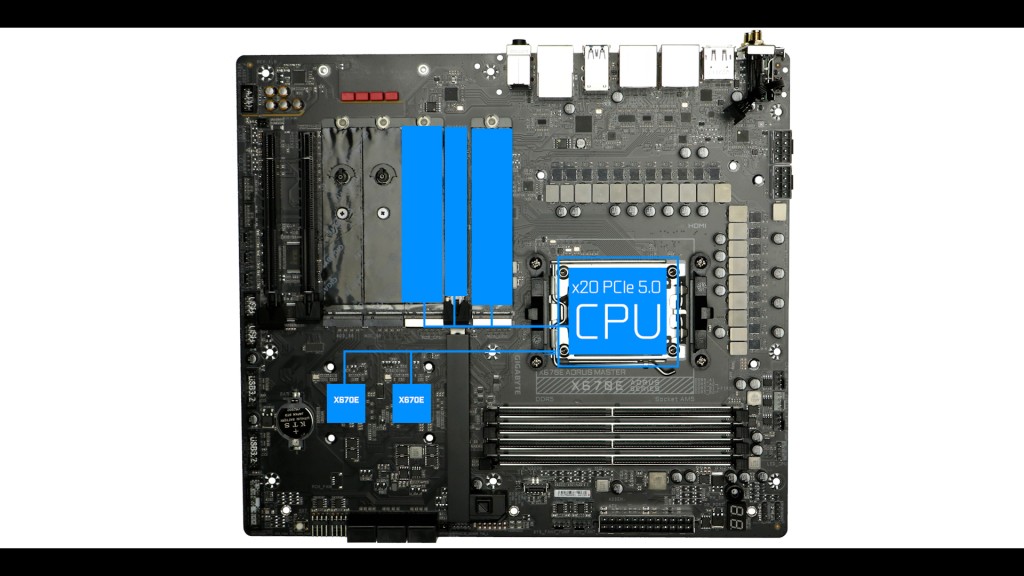
but what really set apart the X670E is that it can utilize the all of 20 PCIe 5.0 lanes from the CPU and allowing a much broader PCIe 5.0 support than on its preceding model.
SATA 3.0
For a more classical storage solutions, we have our usual SATA 3.0 plugs. 6 in total, with a transfer rate of 6 Gbps each. They can be configured to run into a 0,1, 5 or 10 RAID configuration.
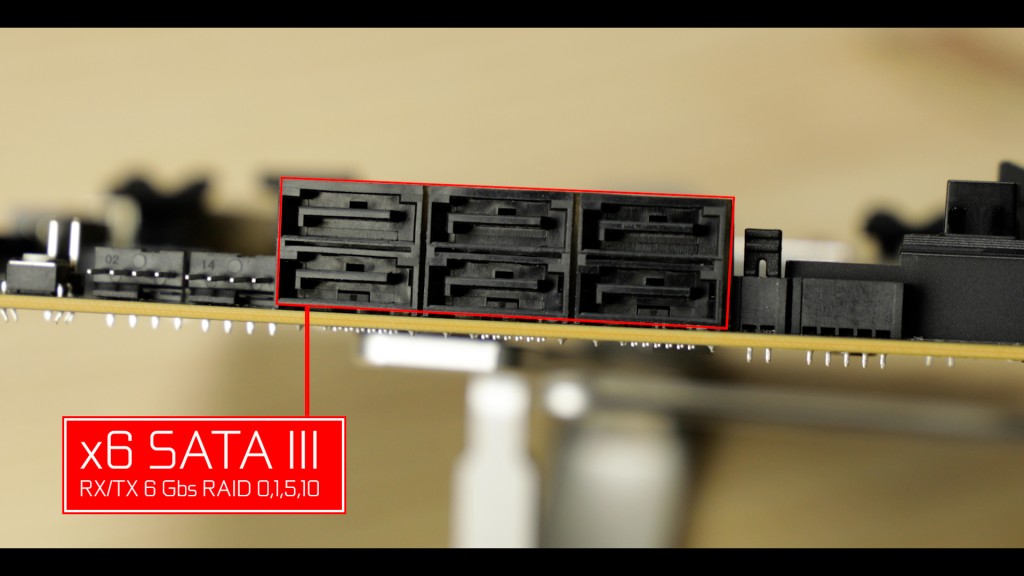
PCIe Slots
We have 3 x16 slots with different speeds.
As usual, only the CPU linked one gets a full 16 PCIe lanes treatment, therefore this is where you want to place your GPU for optimal performances, hence the metallic re-enforcement.
In a single GPU configuration, it can run up-to a very fast PCIe 5.0 fueled 64 GBs.
Our 2nd 16 slot, has nothing to be ashamed about has it shows 4 lanes at PCIe 4.0 standard, for 8 GBs of total bandwidth, great for PCIe based storage,
Our last naked 16 slot, runs at a more modest 2 PCIe 3.0 lanes, for a total of 2 GBs, great for video capture cards.
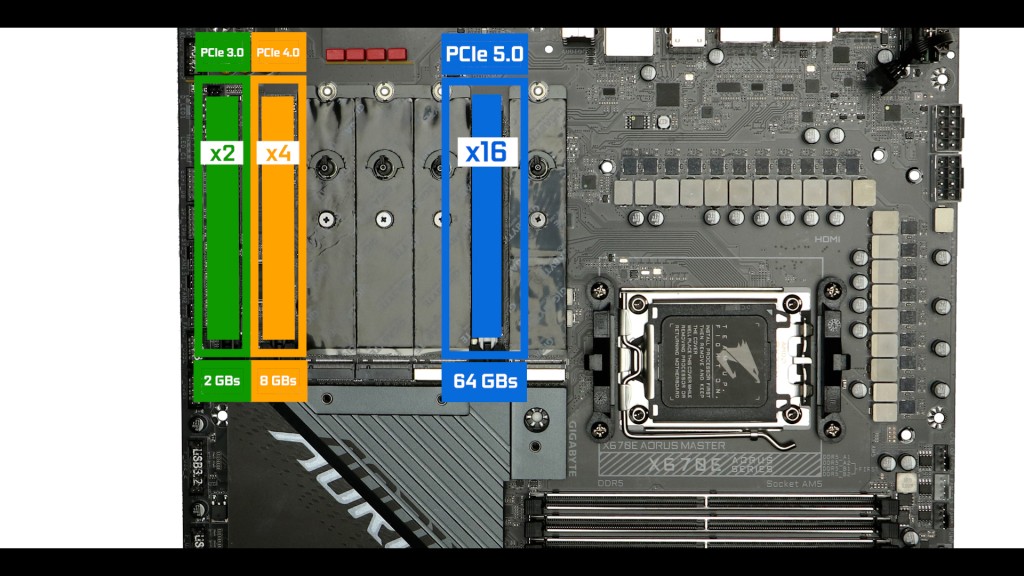
Again last but not least, AORUS decided to take a leap toward the future, and courageously copied ASUS PCIe unlocking mechanism! That is a first for Gigabyte, and I am absolutely thrilled to see this feature bleed through the industry. With the latest gigantic cards, this feature is no luxury.
Not so sure, about the look of it though, I find the button a bit bulky, but that’s me 😊
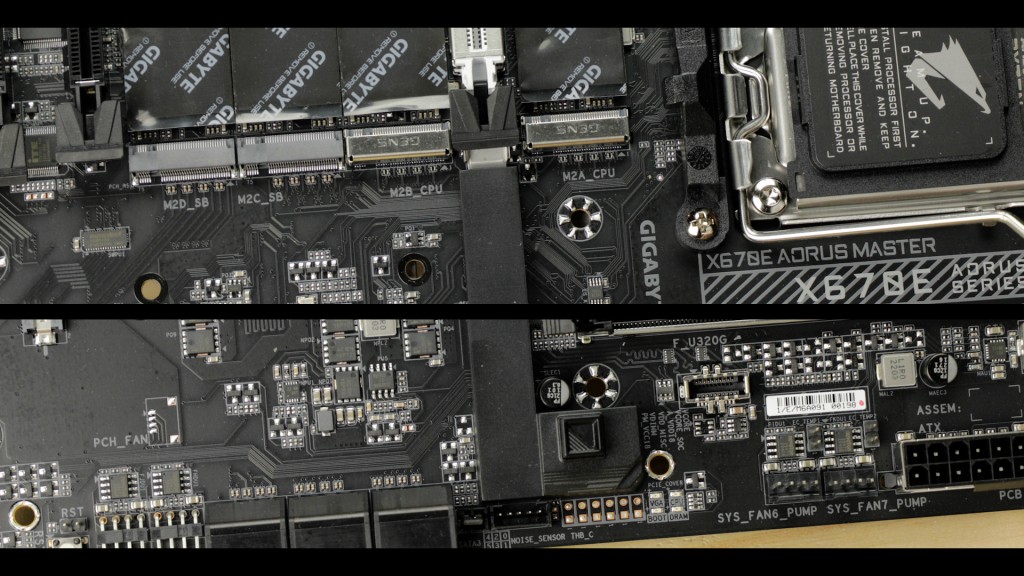
Overall and again the MASTER trails behind the ROG STRIX X670E-E Gaming WiFi offering only a single GPU configuration.
A choice which can make sense if you are planning to use this board in gaming-only context, but I do suspect that the X670E AORUS MASTER was also in the creator collimator and they will surely miss the opportunity to double their GPU power in a production environment.
Back IO
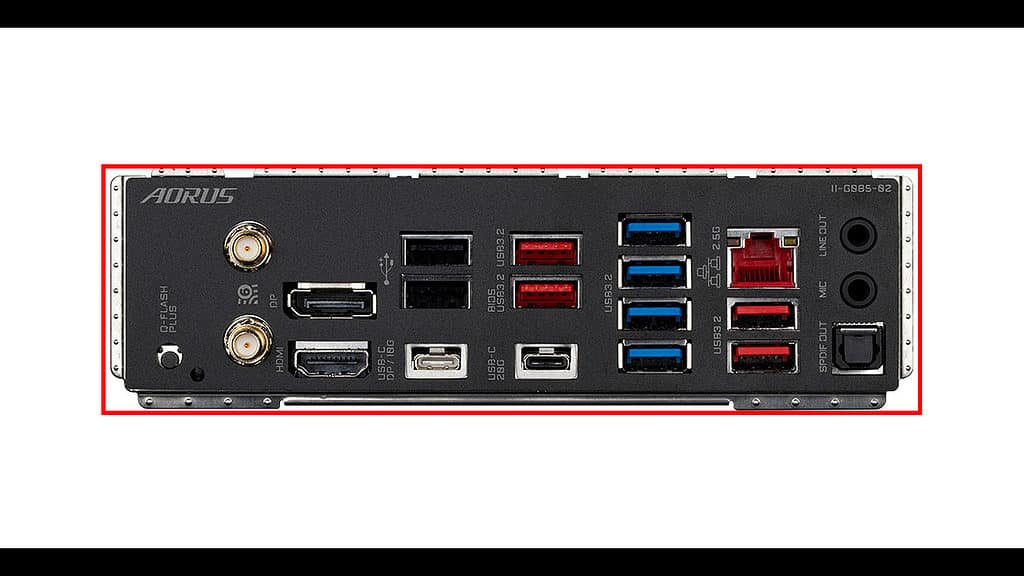
First let me note the presence of an IO integrated plate which is always a good point!
- Q Flash BIOS button
- WiFi 6E dual band adapter (2,4 Gbs / 6GHz) \ BT 5.3
- HDMI 2.1
- Display Port 1.4
- X2 USB 2.0 Gen (480 Mbs)
- x4 USB 3.1 Gen (5 Gbs)
- x5 USB 3.2 2nd Gen all able to transfer data upto 10 Gbs including 1 TYPE-C
- x1 USB 3.2 2nd Gen 2×2 able to transfer data upto 20 Gbs (TYPE-C)
- x1 surge protected Intel I225-V 2.5Gbps LAN controller (step 3)
- ALC 4080 REALTEK audio codec, which is about the best integrated AUDIO Codec a board can have. It takes full advantage of the numerous PCB layers available to it, since both left and right audio channels have been traced on individual PCB layers, further improving its signal isolation and protecting it from static interferences. It is serviced by 500 microfarads worth of capacitors.
But most importantly we do have our WIMA capacitors which brings this codec from good to studio graded stuff. It is simply the best audio codec combination you can find on a motherboard today.
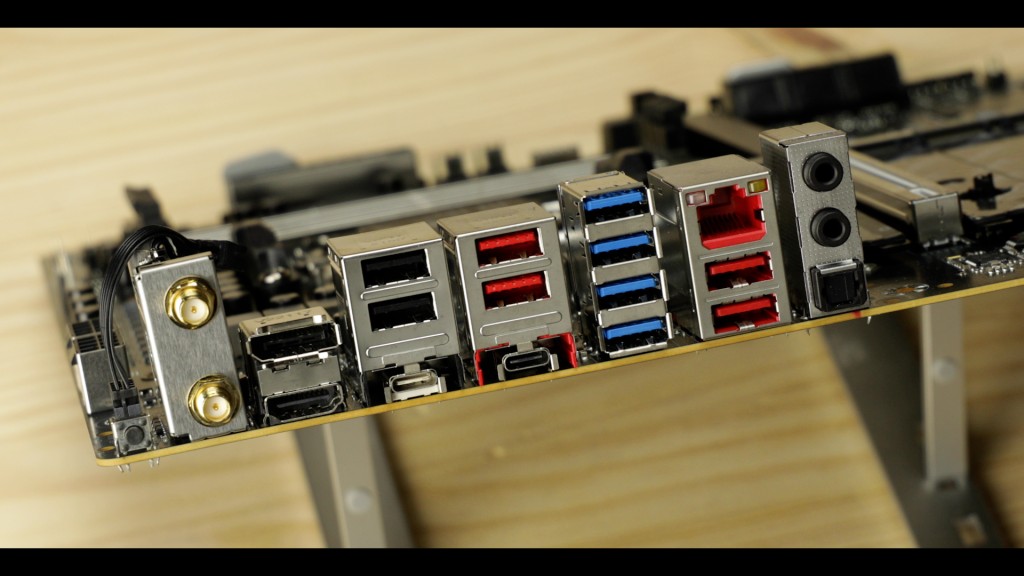
Overall, I find the back IO a little below its pricing level, not nearly matching its STRIX competition. I also regret not finding a clear CMOS button there. Definitely some room for improvement here.
Front Panel Connectors
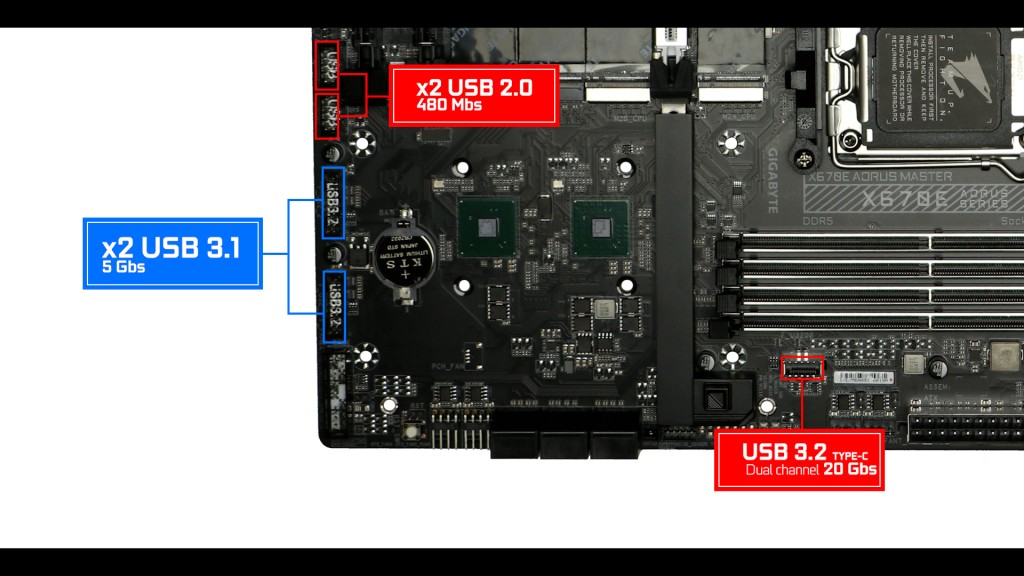
- x2 USB 2.0 (480 Mbs)
- x2 USB 3.0 (5 Gbs)
- x1 USB 3.2 2nd Gen 2×2 (20 Gbs) + fast charge upto 30 watts
- x1 Thunderbolt 4.0 card connector
Upgraded and well featured front panel presence even on the cheaper STRIX B650E-E which is obviously welcome news.
Cooling connectorsCooling wise,
our board has an over the top 10 hybrid fan connectors, which will all support individually either a PWM fan, a water pump or even a flow sensor, which is obviously a gigabyte specific feature and which I find brings so much more enthusiast appeal than any of its competition. I do find that 10 connectors is a little too much given the fact that we are dealing with single GPU board, and that your custom water cooling loops will therefore be quiet limited.
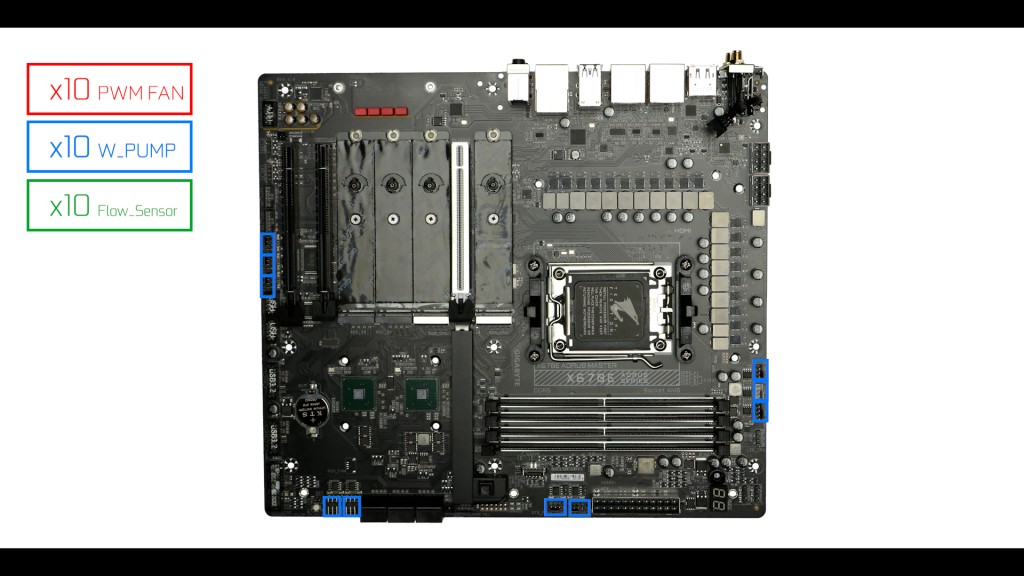
Last note for a feature I think is completely useless! The noise sensor which is suppose to help regulate your fan speed based on the noise they make.
Oh please! I don’t even have to say how moronic that is. The only metric which should commend your fan speed is how hot your components are running. If you want less noise, get low DB fans and a better insulated chassis. Full stop.
EZ Debugger
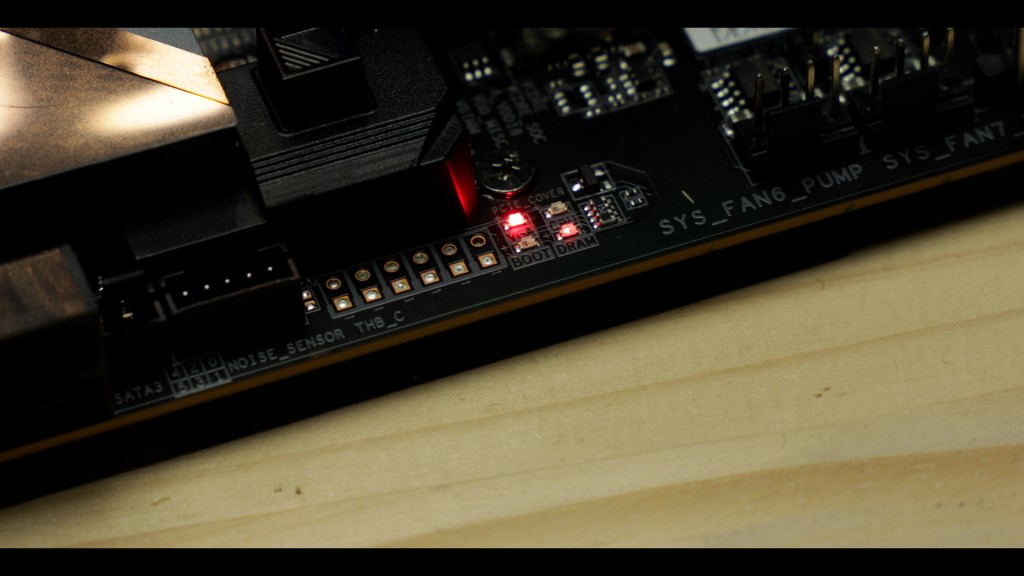
The EZ debugger is really the a must-have on PCIe 4.0 / PCIe 5.0 enabled boards. Especially knowing that X670(E) boards are prone to extended boot times.
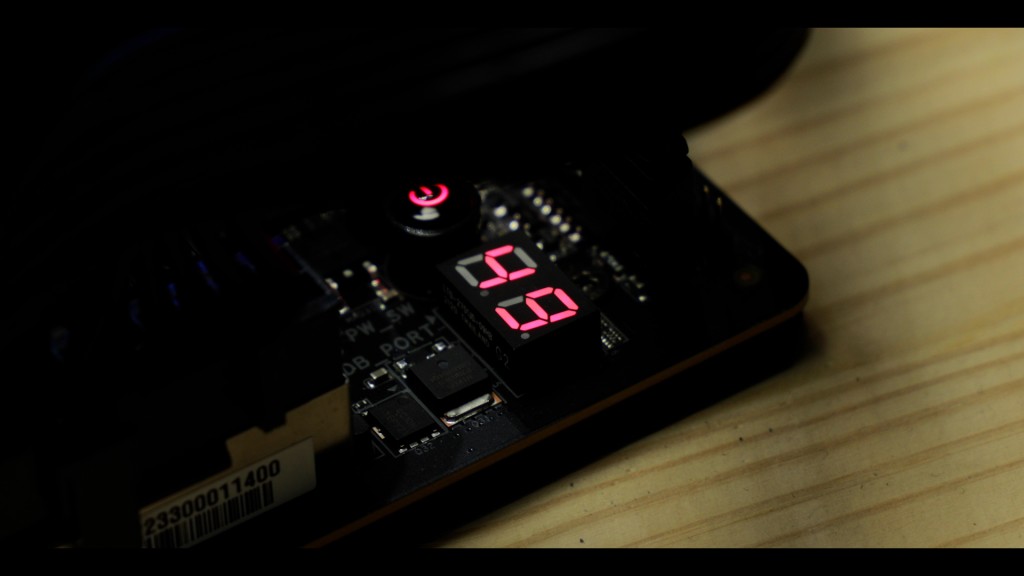
Thankfully we also have a Q-ERROR code screen which will refine our troubleshooting experience to the very reason why your board refuses to boot. In addition, once booted ,the Q-error screen doubles as CPU temps monitor.
Finally we also have our START and RESET soldered buttons which does help with an easy and straight forward power control
Overall a rather premium troubleshooting solution which, well, was very much expected out of a MASTER series.
RGB FUSION Sync Effect
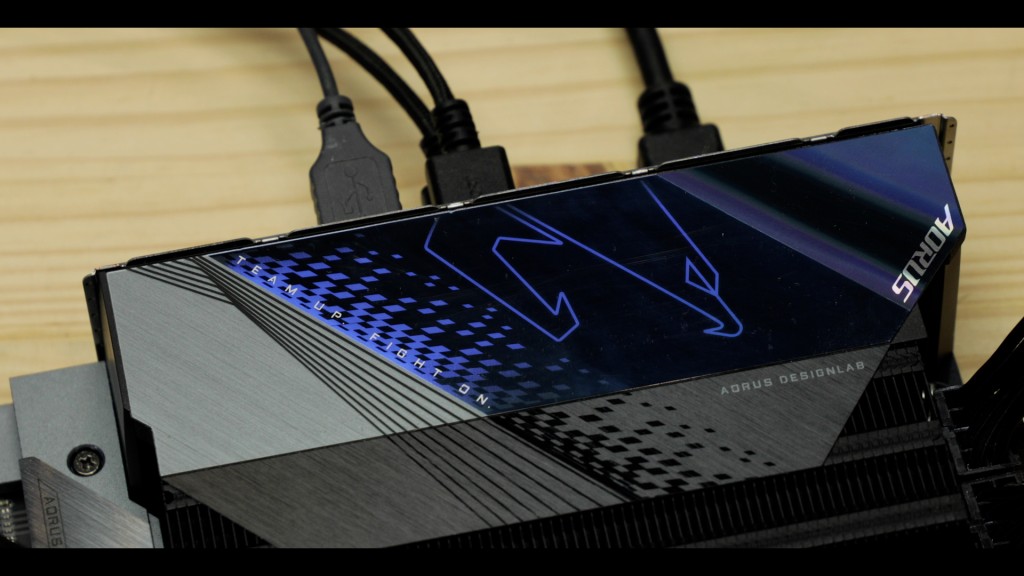
RGB WISE we have A LARGE AORUS branded mirrored plate shading its colors through the IO roofing.
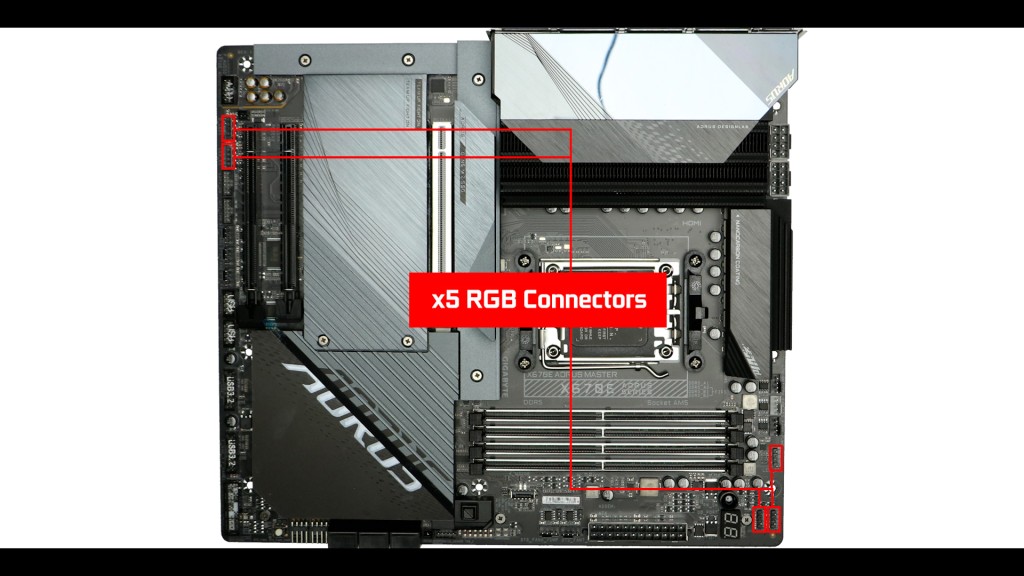
But if that is not enough RGB for you we have x5 FUSION compliant RGB connectors, 3 of which are addressable.
- x5 classic RGB Connectors
- x2 addressable RGB Connectors
All of the above are obviously fully customizable (and sync-able) through GIGABYTE very own FUSION software.
CONCLUSION
The GIGABYTE X670E AORUS MASTER will cost you a hefty 500 bucks, which is in par with its competition, more or less, and the all question i:, it worth it?
Well, I am not that certain.
I always gave stellar reviews to AORUS board, but the fact of the matter here, is that, I feel a few things are missing.
I will grant the fact that we are dealing with a wonderfully engineered, robust CPU centric board, but here is, at least in part some of its weakness, it really is all about the CPU. The VRM is wonderfully powerful, some of the best on the market, but I really feel that the X670E potential was not fully utilized:
No dual GPU support, a shockingly modest back io which by they way is easily surpassed by even some B650E powered boards, and a limited PCIe 5 support on the storage side of things.
It simply is an amazing gamer, but at that price range, and coming from a MASTER series, I did expect more versatility and cater much more to the creator and production users which all that this board missed, are actually quiet central.
Mistakes that the ASUS ROG STRIX X670E-E Gaming WiFi didn’t do, and yes Gigabyte, you should be worried.

